NVIDIA GeForce GTX 670 Review Feat. EVGA: Bringing GK104 Down To $400
by Ryan Smith on May 10, 2012 9:00 AM ESTCompute
Shifting gears, as always our final set of benchmarks is a look at compute performance. As we have seen with GTX 680, GK104 appears to be significantly less balanced between rendering and compute performance than GF110 or GF114 were, and as a result compute performance suffers. Cache and register file pressure in particular seem to give GK104 grief, which means that GK104 can still do well in certain scenarios, but falls well short in others.
Our first compute benchmark comes from Civilization V, which uses DirectCompute to decompress textures on the fly. Civ V includes a sub-benchmark that exclusively tests the speed of their texture decompression algorithm by repeatedly decompressing the textures required for one of the game’s leader scenes. Note that this is a DX11 DirectCompute benchmark.
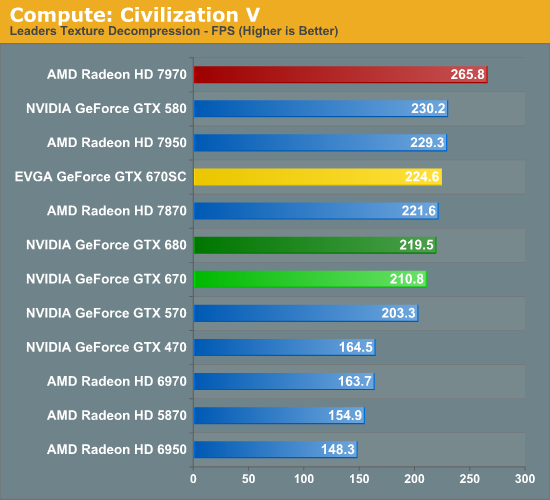
It’s quite shocking to see the GTX 670 do so well here. For sure it’s struggling relative to the Radeon HD 7900 series and the GTX 500 series, but compared to the GTX 680 it’s only trailing by 4%. This is a test that should cause the gap between the two cards to open up due to the lack of shader performance, but clearly that this not the case. Perhaps we’ve been underestimating the memory bandwidth needs of this test? If that’s the case, given AMD’s significant memory bandwidth advantage it certainly helps to cement the 7970’s lead.
Our next benchmark is SmallLuxGPU, the GPU ray tracing branch of the open source LuxRender renderer. We’re now using a development build from the version 2.0 branch, and we’ve moved on to a more complex scene that hopefully will provide a greater challenge to our GPUs.
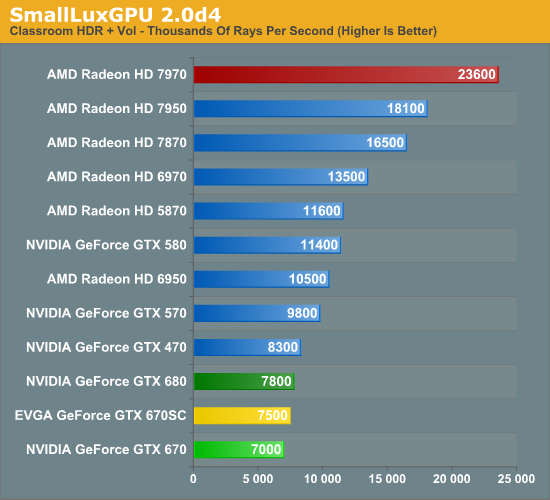
SmallLuxGPU on the other hand finally shows us that larger gap we’ve been expecting between the GTX 670 and GTX 680. The GTX 680’s larger number of SMXes and higher clockspeed cause the GTX 670 to fall behind by 10%, performing worse than the GTX 570 or even the GTX 470. More so than any other test, this is the test that drives home the point that GK104 isn’t a strong compute GPU while AMD offers nothing short of incredible compute performance.
For our next benchmark we’re looking at AESEncryptDecrypt, an OpenCL AES encryption routine that AES encrypts/decrypts an 8K x 8K pixel square image file. The results of this benchmark are the average time to encrypt the image over a number of iterations of the AES cypher.
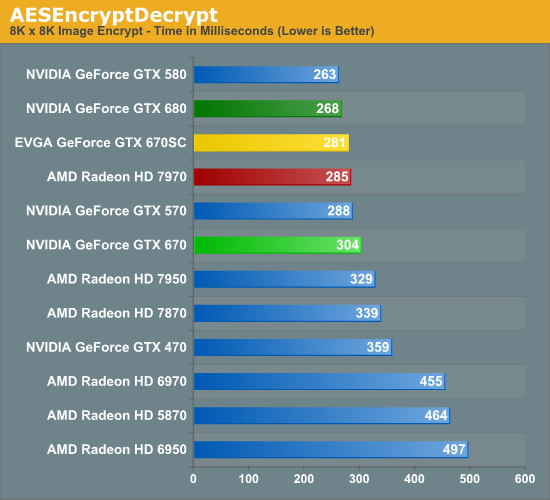
Once again the GTX 670 has a weak showing here, although not as bad as with SmallLuxGPU. Still, it’s enough to fall behind the GTX 570; but at least it’s enough to beat the 7950. Clockspeeds help as showcased by the EVGA GTX 670SC but nothing really makes up for the missing SMX.
Our foruth benchmark is once again looking at compute shader performance, this time through the Fluid simulation sample in the DirectX SDK. This program simulates the motion and interactions of a 16k particle fluid using a compute shader, with a choice of several different algorithms. In this case we’re using an (O)n^2 nearest neighbor method that is optimized by using shared memory to cache data.
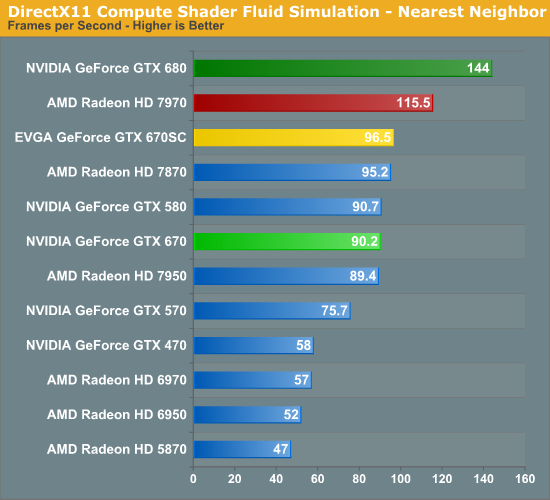
For reasons we’ve yet to determine, this benchmark strongly dislikes GTX 670 in particular. There doesn’t seem to be a performance regression in NVIDIA’s drivers, and there’s not an incredible gap due to TDP, it just struggles on the GTX 670. As a result performance of the GTC 670 only hits 42% of the GTX 680, which is well below what the GTX 670 should theoretically be getting. Barring some kind of esoteric reaction between this program and the unbalanced GPC a driver issue is still the most likely culprit, but it looks to only affect the GTX 670.
Finally, we’re adding one last benchmark to our compute run. NVIDIA and the Folding@Home group have sent over a benchmarkable version of the client with preliminary optimizations for GK104. Folding@Home and similar initiatives are still one of the most popular consumer compute workloads, so it’s something NVIDIA wants their GPUs to do well at.
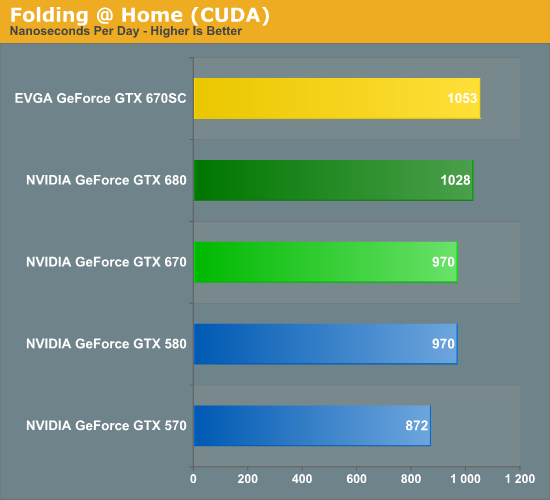
Whenever NVIDIA sends over a benchmark you can expect they have good reason to, and this is certainly the case for Folding@Home. GK104 is still a slouch given its resources compared to GF110, but at least it can surpass the GTX 580. At 970 nanoseconds per day the GTX 670 can tie the GTX 580, while the GTX 680 can pull ahead by 6%. Interestingly this benchmark appears to be far more constrained by clockspeed than the number of shaders, as the EVGA GTX 670SC outperforms the GTX 680 thanks to its 1188MHz boost clock, which it manages to stick to the entire time.










414 Comments
View All Comments
Samus - Thursday, May 10, 2012 - link
I'm just pissed I bought a GTX560 448 Core (basically a GTX570) just four months ago, and now its completely outdated lol.SlyNine - Thursday, May 10, 2012 - link
Then I'd recommend never buying videocards.On the other hand a GTX 560 may not be the newest card in its price bracket, outdated seems to be a harsh word. You still get the same performance you paid for, it's not going to drop just because something newer came out.
My 5870 was 2 1/2 years old, cost me 384$ at the time, The price/performance stayed relevant right until the 680GTX came out.
Papaspud - Thursday, May 10, 2012 - link
Exactly, I was running a GTX 285, and it didn't { slow down} when the new cards came out. Decide what card you want and be happy, the next new card is always on the way, and your card won't be the bestest forever.I was lucky and camped newegg when the GTX 680's came out and scored, very good card, but that being said AMD's cards are very nice too and I would be more than happy with one of those too, but I invested in a 3D setup so I am kind of stuck in Nvidia land for now.
As far as I can see, all of the high end cards are really nice, decide which one is for you and be happy, don't feel like you need to justify your purchase to unknown people on the internet.
will54 - Thursday, May 10, 2012 - link
Finally someone that doesn't put down one brand over the other just to justifiy his purchase. In the end these cards are plenty enough for most resolutions and games. If 3d and physx and such is something important to you go Nvidia and if Compute and zero core tech is important go AMD. The fact that both companies are strong only improves the product and price.CeriseCogburn - Friday, May 11, 2012 - link
you won't be using 7970 and 7950 for compute, those cards are thousands of dollars and have special configs and special drivers, and don't even carry the same card name, although the cores are similarhttp://www.newegg.com/Product/Product.aspx?Item=N8...
Way over 2 grand baby. That strikes down the one lie for amd, no points amd fan.
Onto the second talking point - zero core - it shows about 3 watts difference at idle, but once a person uses the card, the 7970 loses hours of advantage doing nothing in a few minutes, hence it's power bill cost will be much more anyway. That's another zero points for amd.
I'll wait till you think of something that isn't a big fat lie and trick to claim the amd cards are "good too"....
If you're going to be a good fair and peaceful person willing to bring together the forum you had better come up with something solid for amd.
We don't get to just say it's all even steven because amd loses so miserably, and then pretend it's true, while (you) spewing an outright lie and deception (firepro) and a secondary loss as a win (power).
SlyNine - Saturday, May 12, 2012 - link
There are plenty of people using consumer grade cards for compute.CeriseCogburn - Sunday, May 13, 2012 - link
Sure, plenty, plenty, plenty here never use it, and now they have one thing they can use it for with an amd card - winzip-Count your many blessings amd fan.
What a joke you people are.
There are nVidia driver hacks available BTW - whereby you can increase perf of the many released nVidia gaming cards and attempt some grand performance, but of course you guys have done that already for the past 3 generations like your opposition here, huh....
Yes, you're so well versed.
Galidou - Sunday, May 13, 2012 - link
And here comes the fanboy to break the dream of neutrality, we will never be alone. We just said we were happy that someone commented about whatever brand people buy, as long as you are happy with your purchase.''Perception is what matters, someone who buys a honda civic can be as happy as someone who buys a Ferrari, sure the feeling of driving it will be different. But in the end, it's the perception towards life that matters.
CeriseCogburn - Sunday, May 13, 2012 - link
Someone who had to buy Nvidia for the 3D, since amd sucks so badly at it, owned nVidia (285) prior, and thus, essentially has zero amd experience.Yes, be happy, ignorance is bliss, in even the face of epic fail (no amd 3D use worth crap).
I mean is that what you want, someone kissing your inner feeling child so the lie you live can remain ?
It seems so.
CeriseCogburn - Friday, May 11, 2012 - link
I see SlyNine.... so the jump from your 5870 to the next tier, the 6970 was crap, and then to 7970 was crap, only becoming relevant when the 680GTX hit:" My 5870 was 2 1/2 years old, cost me 384$ at the time, The price/performance stayed relevant right until the 680GTX came out. "
So according to you, the last 2 amd flagship releases even combined were not of sufficient jump percentage...
I guess that's another giant mark in the destruction of the recently popularized complaint about this release "being the smallest jump we've ever seen".